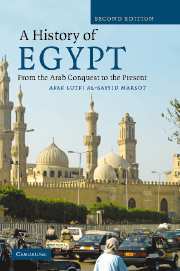Book contents
- Frontmatter
- Contents
- List of maps
- Preface
- Map 1 Egypt and its neighbours
- Map 2 Medieval Cairo
- 1 The Arab conquest of Egypt to the end of the Ayyubi dynasty, 639–1250
- 2 The age of the mamluks, 1250–1516
- 3 The Ottoman age, 1516–1805
- 4 The beginning of the state system, 1805–1922
- 5 The liberal experiment, 1922–52
- 6 The Nasser years, 1952–70
- 7 From Sadat to Mubarak, 1970 to the present day
- Select bibliography
- Index
2 - The age of the mamluks, 1250–1516
Published online by Cambridge University Press: 05 June 2012
- Frontmatter
- Contents
- List of maps
- Preface
- Map 1 Egypt and its neighbours
- Map 2 Medieval Cairo
- 1 The Arab conquest of Egypt to the end of the Ayyubi dynasty, 639–1250
- 2 The age of the mamluks, 1250–1516
- 3 The Ottoman age, 1516–1805
- 4 The beginning of the state system, 1805–1922
- 5 The liberal experiment, 1922–52
- 6 The Nasser years, 1952–70
- 7 From Sadat to Mubarak, 1970 to the present day
- Select bibliography
- Index
Summary
A great danger faced the mamluks, that of the advance of the Mongol horde under Hulagu, grandson of Genghis Khan, the man who had razed the fabled city of Baghdad in February 1258 and ended the reign of the Abbassi dynasty over the eastern Muslim world. From then on the focus of Islamic government was to lie with the western Muslim states. Hulagu's forces, unchallenged by any army, moved westward to occupy Syria. The only army capable of standing up to the Mongols were the mamluks of Egypt, who under the leadership of Baibars defeated the Mongols in the battle of Ain Jalut (the Eye of Goliath). Baibars hoped to be rewarded by the governorship of the province of Syria for his victory, but when he was baulked in his ambitions he conspired with other mamluk amirs (generals), and they assassinated the mamluk general who had been placed on the throne and replaced him with Baibars in 1260. Baibars, and all the mamluks who followed him on the throne, took on the title of sultan, an Arabic word meaning ‘power’, and a title which had been used by the Ayyubis. Even after the Abbassi caliphate had been destroyed the mamluks did not use the term ‘caliph’, which fell into disuse because it was identified with a losing dynasty preferring to continue using the term ‘sultan’.
Throughout their period of domination the mamluks were deeply feared and respected by their neighbours because of their martial valour.
- Type
- Chapter
- Information
- A History of EgyptFrom the Arab Conquest to the Present, pp. 31 - 47Publisher: Cambridge University PressPrint publication year: 2007



